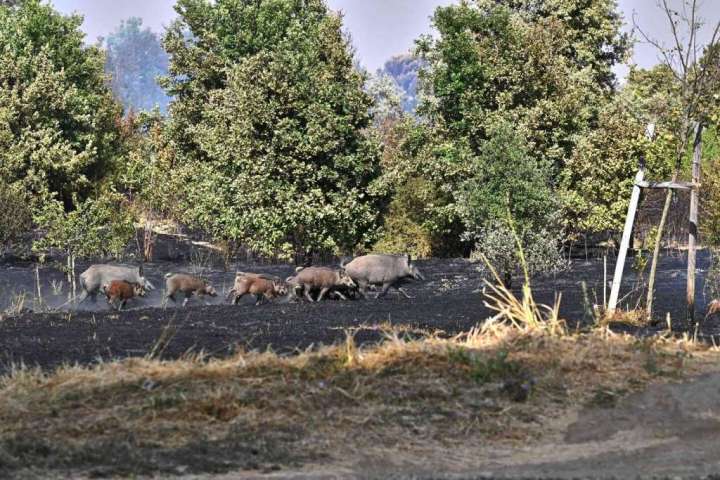ROME — Wild boars have emerged as a force of chaos in Italy’s capital over the past decade, feasting on refuse, disrupting traffic and encroaching on the Vatican.
Wild boars that roam Rome must be killed, officials say

But their days could be numbered. In recent months, authorities have begun a cull over concern that the boars could spread African swine fever, harmless to humans and pets, but deadly to pigs raised commercially, a sector that supports some 100,000 jobs. Fear of the virus has already prompted several countries, including China, to impose costly import bans on Italian pork.
A government task force created in March set in motion plans to reduce the country’s boar population — estimated in the several millions — by 50 percent, after carcasses infected with African swine fever were found in northwestern Italy earlier this year, followed by more recent cases, including in Rome. Efforts to wipe out the virus could be an uphill battle.
“I don’t see the eradication of the disease as a possibility, unless you bring about a strong reduction of the [boar] population,” says Angelo Ferrari, an expert assigned by the government to address the boar crisis. “The thing is, there’s just too many of them.”
Even as some boars are culled, others continue to reproduce and enter Rome via nature reserves and parks that extend deep into the city, lured by the chance to feast on trash.
They travel together. “The wild boar is not unlike us: smart, social, lives in groups, super adaptable, omnivorous: It’s an animal for all seasons, and habitats,” says Luigi Boitani, a zoologist at Sapienza University in Rome.
The wild boar population in Europe has spiked sharply in recent decades due to “a combination of factors” including high reproduction rates and lack of large predators, according to studies, and they have increasingly shown up near parks and forested areas in urban centers such as Rome, Berlin and Barcelona. The problem drew worldwide, albeit brief, attention when the singer Shakira said she and her son were accosted by a pair of wild boars in a Barcelona Park in 2021. The creatures grabbed her bag containing her mobile phone and took off into the woods, she said.
The numbers have grown beyond what predators such as wolves could control, Boitani said.
The plan in Rome, according to Ferrari, involves letting the virus make its way through the wild boar population inside a designated “red zone” near the city center, sealed off by special nets and gates. Some trash cans are being modified to keep boars out. More than a dozen traps have already been installed outside of Rome’s Great Ring Junction, the orbital motorway encircling the city, with more to follow.
The task “wouldn’t necessarily require ‘cowboys’ to go prowling trigger-happy around Rome, but surely we’ll need the help of hunters” with licenses,Ferrari said.
In Piedmont, where the virus was detected in early January, authorized “selective hunters” have already put down around 3,500 boars. In Rome, the cull that began in late June is soon set to shift into high gear.
Neither treatment nor vaccine has been found as of yet for the African swine fever, which kills 98 percent of swine infected. Because the virus can survive on surfaces, even in soil, signs have been appearing around Rome’s designated zone, west of the river Tiber, asking park visitors to sanitize their shoes once they leave.
The threat to the Italian pork industry is so dramatic that at the end of May, farmers across the country held protests to call for a government response. If the disease makes its way into hog farms, pigs raised for meat will have to be culled as well. Farmers demonstrating in Rome, wearing boar masks, crouched in imitation of boars, chanting: “The boar needs be stopped!”
In early June, David Granieri, head of the local chapter of the Coldiretti farmers’ association, told The Washington Post that two infected pigs had been found in a small farm within Rome’s city limits. Some 1,200 pigs had to be culled.
Around Rome, Granieri said, there are tens of thousands of pigs at risk. But the more serious threat is that infections could break out on massive pig farms to the north. “Just think of the San Daniele prosciutto and of the prosciutto of Parma,” Granieri said, referring to well-known cured meats. “It would get very serious, very quickly.” So far, more than 14,000 farm pigs have had to be eliminated across Piedmont and Liguria as a precautionary measure.
The spread of African swine fever would jeopardize a sector that brings in more than $20 billion in annual revenue, according to official estimates. “It’s an industry of fundamental import,” says deputy health minister Andrea Costa. For that reason, the government has allotted an initial figure of some 15 million dollars to secure pig farms. “We’re quite worried,” Alessandro Utini, head of the Parma Ham Consortium, which protects the Prosciutto di Parma designation, told The Post.
Import pauses on Italian pork on the part of China, Japan and others have already wrought $20 million worth of damage, the consortium estimates.
Farmers and Italian authorities are concerned that a U.S. pause could come next.
Well before the Italian outbreak, the virus had already begun to spread among pig populations in China and several Northern European countries.
Italy’s planned cull has been met with resistance from animal rights groups.
“Killing them should only be a last resort,” says Roberto Vecchio, head of a local anti-hunting league, who argues that the boars should instead be sterilized — which he calls an unnatural but bloodless solution — and carted off to be set free.
Meanwhile, the boars of Rome continue to make the city their own, cooling off in fountains and lounging on sidewalks. A few have attacked people, but in some neighborhoods they are still adopted by local communities and given nicknames.






